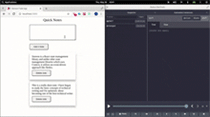
本篇文章给大家介绍一下React中使用事件驱动进行状态管理的方法。有一定的参考价值,有需要的朋友可以参考一下,希望对大家有所帮助。

自 Hook 被引入 React 以来,Context API 与 Hook 库在应用状态管理中被一起使用。但是把 Context API 和 Hooks(许多基于 Hooks 的状态管理库建立在其基础上)组合的用法对于大规模应用来说可能效率不高。
由于必须创建一个自定义的 Hook 才能启用对状态及其方法的访问,然后才能在组件中使用它,所以在实际开发中很繁琐。这违反了 Hook 的真正目的:简单。但是对于较小的应用,Redux 可能会显得太重了。
今天我们将讨论 Context API 的替代方法:Storeon。 Storeon 是一个微型的、事件驱动的 React 状态管理库,其原理类似于 Redux。用 Redux DevTools 可以查看并可视化状态操作。 Storeon 内部使用 Context API 来管理状态,并采用事件驱动的方法进行状态操作。
【相关教程推荐:React视频教程】
store 是在应用程序状态下存储的数据的集合。它是通过从 Storeon 库导入的 createStoreon() 函数创建的。
createStoreon() 函数接受模块列表,其中每个模块都是一个接受 store 参数并绑定其事件监听器的函数。这是一个store 的例子:
import { createStoreon } from 'storeon/react'
// todos module
const todos = store => {
store.on(event, callback)
}
export default const store = createStoreon([todos])Storeon 中的 store 是模块化的,也就是说,它们是独立定义的,并且没有被绑定到 Hook 或组件。每个状态及其操作方法均在被称为模块的函数中定义。这些模块被传递到 createStoreon() 函数中,然后将其注册为全局 store。
store 有三种方法:
store.get() – 用于检索状态中的当前数据。
store.on(event, callback) – 用于把事件侦听器注册到指定的事件名称。
store.dispatch(event, data) – 用于发出事件,并根据定义的事件要求将可选数据传递进来。
Storeon 是基于事件的状态管理库,状态更改由状态模块中定义的事件发出。 Storeon 中有三个内置事件,它们以 @ 开头。其他事件不带 @ 前缀定义。三个内置事件是:
@init – 在应用加载时触发此事件。它用于设置应用的初始状态,并执行传递给它的回调中的所有内容。
@dispatch – 此事件在每个新动作上触发。这对于调试很有用。
@changed – 当应用状态发生更改时,将触发此事件。
注意:store.on(event,callback) 用于在我们的模块中添加事件监听器。为了演示在 Storeon 中如何执行应用程序状态操作,我们将构建一个简单的 notes 程序。还会用 Storeon 的另一个软件包把状态数据保存在 localStorage 中。
假设你具有 JavaScript 和 React 的基本知识。你可以在 https://github.com/Youngestde... 上找到本文中使用的代码。
在深入探讨之前,让我们先勾勒出 Notes 程序所需的项目结构和依赖项的安装。从创建项目文件夹开始。
mkdir storeon-app && cd storeon-app
mkdir {src,public,src/Components}
touch public/{index.html, style.css} && touch src/{index,store,Components/Notes}.js接下来,初始化目录并安装所需的依赖项。
npm init -y npm i react react-dom react-scripts storeon @storeon/localstorage uuidv4
接下来就是在 index.js文件中编写父组件了。
index.js这个文件负责渲染我们的笔记组件。首先导入所需的包。
import React from 'react'
import { render } from 'react-dom';
function App() {
return (
<>
Hello!
</>
);
}
const root = document.getElementById('root');
render(<App />, root);接下来通过在 store.js 中编写用于状态的初始化和操作的代码来构建 store。
store.js此文件负责处理应用中的状态和后续状态管理操作。我们必须创建一个模块来存储状态以及支持事件,以处理操作变更。
首先,从 Storeon 导入 createStoreon 方法和唯一随机ID生成器 UUID。
createStoreon 方法负责将我们的 状态 注册到全局 store 。
import { createStoreon } from 'storeon';
import { v4 as uuidv4 } from 'uuid'
import { persistState } from '@storeon/localstorage';
let note = store => {}我们将状态存储在数组变量 notes 中,该变量包含以下格式的注释:
{
id: 'note id',
item: 'note item'
},接下来,我们将用两个注释(在首次启动程序时会显示)来初始化状态,从而首先填充注释模块。然后,定义状态事件。
let note = store => {
store.on('@init', () => ({
notes: [
{ id: uuidv4(), item: 'Storeon is a React state management library and unlike other state management libraries that use Context, it utilizes an event-driven approach like Redux.' },
{ id: uuidv4(), item: 'This is a really short note. I have begun to study the basic concepts of technical writing and I'\'m optimistic about becoming one of the best technical writers.' },
]
});
store.on('addNote', ({ notes }, note) => {
return {
notes: [...notes, { id: uuidv4(), item: note }],
}
});
store.on('deleteNote', ({ notes }, id) => ({
notes: notes.filter(note => note.id !== id),
});
}在上面的代码中,我们定义了状态,并用两个简短的注释填充了状态,并定义了两个事件和一个从 dispatch(event, data) 函数发出事件后将会执行的回调函数。
在 addNote 事件中,我们返回添加了新 note 的更新后的状态对象,在 deleteNote 事件中把 ID 传递给调度方法的 note 过滤掉。
最后,把模块分配给可导出变量 store ,将其注册为全局 store,以便稍后将其导入到上下文 provider 中,并将状态存储在 localStorage 中。
const store = createStoreon([ notes, // Store state in localStorage persistState(['notes']), ]); export default store;
接下来,在 Notes.js 中编写 Notes 应用组件。
Notes.js此文件包含 Notes 程序的组件。我们将从导入依赖项开始。
import React from 'react';
import { useStoreon } from 'storeon/react';接下来,编写组件。
const Notes = () => {
const { dispatch, notes } = useStoreon('notes');
const [ value, setValue ] = React.useState('');
}在上面的代码的第二行中,useStoreon() hook 的返回值设置为可破坏的对象。 useStoreon() hook 使用模块名称作为其参数,并返回状态和调度方法以发出事件。
接下来定义在组件中发出状态定义事件的方法 。
const Notes = () => {
...
const deleteNote = id => {
dispatch('deleteNote', id)
};
const submit = () => {
dispatch('addNote', value);
setValue('');
};
const handleInput = e => {
setValue(e.target.value);
};
}Let’s review the three methods we defined the above:
让我们回顾一下上面定义的三种方法:
deleteNote(id) – 此方法在触发时调度 deleteNote 事件。
submit() – 该方法通过传递输入状态的值来调度 addNote 事件,该状态在 Notes 组件中本地定义。
handleInput() – 此方法将本地状态的值设置为用户输入。
Next, we’ll build the main interface of our app and export it.
接下来,我们将构建应用程序的主界面并将其导出。
const Notes = () => {
...
return (
<section>
<header>Quick Notes</header>
<div className='addNote'>
<textarea onChange={handleInput} value={value} />
<button onClick={() => submit()}> Add A Note </button>
</div>
<ul>
{notes.map(note => (
<li key={note.id}>
<div className='todo'>
<p>{note.item}</p>
<button onClick={() => deleteNote(note.id)}>Delete note</button>
</div>
</li>
))}
</ul>
</section>
);
}这样就构成了我们的 Notes 组件。接下来为我们的应用和 index.html 文件编写样式表。
index.html<!DOCTYPE html>
<html>
<head>
<meta charset="UTF-8">
<meta name="viewport" content="width=device-width, initial-scale=1.0">
<meta http-equiv="X-UA-Compatible" content="ie=edge">
<link rel="stylesheet" href="style.css">
<title>Storeon Todo App</title>
</head>
<body>
<div id="root"></div>
</body>
</html>接下来,填充我们的 style.css 文件。
style.css* {
box-sizing: border-box;
margin: 0;
padding: 0;
}
section {
display: flex;
justify-content: center;
align-items: center;
flex-direction: column;
width: 300px;
margin: auto;
}
header {
text-align: center;
font-size: 24px;
line-height: 40px;
}
ul {
display: block;
}
.todo {
display: block;
margin: 12px 0;
width: 300px;
padding: 16px;
box-shadow: 0 8px 12px 0 rgba(0, 0, 0, 0.3);
transition: 0.2s;
word-break: break-word;
}
li {
list-style-type: none;
display: block;
}
textarea {
border: 1px double;
box-shadow: 1px 1px 1px #999;
height: 100px;
margin: 12px 0;
width: 100%;
padding: 5px 10px;
}
button {
margin: 8px 0;
border-radius: 5px;
padding: 10px 25px;
}
.box:hover {
box-shadow: 0 8px 16px 0 rgba(0, 0, 0, 0.2);
}现在我们已经成功编写了组件和样式表,但是还没有更新 index.js 中的父组件来渲染 Notes 组件。接下来让我们渲染 Notes 组件。
index.js要访问我们的全局 store,必须导入 store 和 Storeon store 上下文组件。我们还将导入 notes 组件来进行渲染。
用以下代码替换组件的内容:
import React from 'react';
import { render } from 'react-dom';
import { StoreContext } from 'storeon/react';
import Notes from './Components/Notes';
import store from '../src/store';
function App() {
return (
<>
<StoreContext.Provider value={store}>
<Notes />
</StoreContext.Provider>
</>
);
}
const root = document.getElementById('root');
render(<App />, root);在第 8-10 行,调用 store 上下文提供程序组件,并将 notes 组件作为使用者传递。store 上下文提供程序组件将全局 store 作为其上下文值。
接下来把 package.json 文件中的脚本部分编辑为以下内容:
"scripts": {
"start": "react-scripts start",
}然后运行我们的程序:
npm run start
让我们继续添加和删除注释:

Storeon 与 Redux 有着相似的属性,可以在 Redux DevTools 中可视化和监视状态的更改。为了可视化 Storeon 程序中的状态,我们将导入 devtools 包,并将其作为参数添加到我们 store.js 文件的 createStoreon() 方法中。
...
import { storeonDevtools } from 'storeon/devtools';
...
const store = createStoreon([
...,
process.env.NODE_ENV !== 'production' && storeonDevtools,
]);这是用 Redux DevTools 可视化状态变化的演示:

Storeon 是一个非常有用的状态管理库,它用事件驱动和 Redux 改编的模块化样式来管理状态。你可以在https://github.com/Youngestdev/storeon-app上找到本文中的代码。
原文地址:https://blog.logrocket.com/event-driven-state-management-in-react-using-storeon/
作者:Abdulazeez Abdulazeez Adeshina
更多编程相关知识,请访问:编程视频!!
Atas ialah kandungan terperinci 浅谈React+Storeon进行状态管理的方法. Untuk maklumat lanjut, sila ikut artikel berkaitan lain di laman web China PHP!
 Mengapa telefon saya tidak dimatikan tetapi apabila seseorang menghubungi saya, telefon itu menggesa saya untuk mematikannya?
Mengapa telefon saya tidak dimatikan tetapi apabila seseorang menghubungi saya, telefon itu menggesa saya untuk mematikannya?
 mysql mencipta pangkalan data
mysql mencipta pangkalan data
 Bagaimana untuk menyelesaikan terlalu banyak log masuk
Bagaimana untuk menyelesaikan terlalu banyak log masuk
 Cara menggunakan dc.rectangle
Cara menggunakan dc.rectangle
 Matikan kemas kini automatik win10
Matikan kemas kini automatik win10
 Perwakilan binari nombor negatif
Perwakilan binari nombor negatif
 iPhone 4 jailbreak
iPhone 4 jailbreak
 Bina pelayan git anda sendiri
Bina pelayan git anda sendiri
 Apakah kelebihan rangka kerja SpringBoot?
Apakah kelebihan rangka kerja SpringBoot?